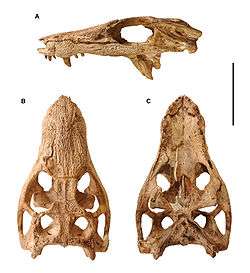Araripesuchus buitreraensis
Araripesuchus buitreraensis is a crocodylomorph of the genus Araripesuchus. It lived during the Cretaceous period, approximately 99–96 million years ago, in northern Patagonia, Argentina. Its fossil remains were found in the locality of La Buitrera, Río Negro Province.[1] This species was found in the Candeleros Formation (Río Limay Subgroup), aged Cenomanian (Late Cretaceous).[2]
| Araripesuchus buitreraensis | |
|---|---|
 | |
| Skull of the genus Araripesuchus | |
| Scientific classification | |
| Kingdom: | Animalia |
| Phylum: | Chordata |
| Class: | Reptilia |
| Suborder: | †Notosuchia |
| Family: | †Uruguaysuchidae |
| Genus: | †Araripesuchus |
| Species: | †A. buitreraensis |
| Binomial name | |
| †Araripesuchus buitreraensis Pol & Apesteguia, 2005 | |
Discovery
This notosuchian[3][4] was found in the locality of La Buitrera in the late 1990s[5], in the Candeleros Formation (Cenomanian–Turonian). These outcrops are located 30 km of Cerro Policía, Río Negro (northwest Patagonia). The faunal assemblage of this locality includes dryolestids, theropods, crocodyliforms, snakes, sphenodontians, and fragmentary remains of frogs and fish. The Candeleros Formation, in Neuquén, was characterized by a diverse fauna that included titanosaurian and diplodocoid sauropods, carcharodontosaurid theropods, chelid turtles, pipoid anurans, and the crocodyliform Araripesuchus patagonicus. However, the fauna of La Buitrera is different from other types of fauna, including abundant fossils of small vertebrates. The term Buitreraensis refers to the place where the specimen was found, that is, in the locality of La Buitrera.[6]
Taxonomy

The species Araripesuchus buitreraensis shares phylogenetic characteristics with the clade Araripesuchus. The diagnostic characteristics that make this species different from others of the same genus are its pterygoid flanges, which are pneumatic and poorly expanded at its lateral end. Another characteristic is its transversely elongated depression on the ventral surface of the pterygoid flanges, which is close to the posterior margin of the suborbital fenestra.[6] The specimen found in La Buitrera (MPCA-Pv 235), which belongs to the holotype of the species, is considerably different from all known specimens of Araripesuchus patagonicus. For example, in the species A. patagonicus, the frontal does not extend into the supratemporal fossa, and the parietal and postorbital come into contact extensively within this opening. In the specimen MPCA-Pv 235, however, the frontal extends widely into the supratemporal fossa, and reaches the margin of the supratemporal fenestra. Therefore, the parietal and postorbital do not come into contact.[6] As regards the general form of the brain of Araripesuchus buitreraensis, it resembles closely that of the species Araripesuchus wegeneri, and differs significantly from that of Alligator and Anatosuchus. Although its cerebral hemispheres are less compressed dorsoventrally than in the African species, the sinus that separate them is well marked.[1] This phylogenetic analysis shows that Araripesuchus is a basal clade of mesoeucrocodylians. The South American taxa are more closely related to each other than to the African species Araripesuchus wegeneri from the Early Cretaceous.[6]
References
- Apesteguía, Sebastián (2013). "Un primer vistazo al endocráneo y estructuras asociadas de Araripesuchus buitreraensis Pol y Apesteguía, 2005 (Crocodyliformes)". Jornada; XXVII Jornadas Argentinas de Paleontologia de Vertebrados.
- Arbucci, Andrea; Filippi, Leonardo; Calvo, Jorge (2011). "Un nuevo mesoeucrocodylia cretácico del norte de la cuenca neuquina, Argentina". Revista Brasileira de Paleontologia. doi:10.4072/rbp.2011.1.05
- Gianechini, Federico Abel (2014). "Revisión de los Deinonychosauria (Dinosauria, Theropoda) de la Argentina: anatomía y filogenia". Facultad de Ciencias Exactas y Naturales. Universidad de Buenos Aires.
- Apesteguía, Sebastián; Ares, Roberto (2010). "Anexo: La evolución en acción Origen y Diversidad de los reptiles modernos: tortugas, lagartos, cocodrilos y aves". Vida en evolución: la historia natural vista desde Sudamérica. Buenos Aires: Vázquez Mazzini Editores. pp. 238-240. ISBN 978-987-9132-25-8.
- Apesteguía, Sebastián (2017). "El área paleontológica de la buitrera: 45 kilómetros de desierto cretácico". 31º Jornadas Argentinas de Paleontología de Vertebrados.
- Pol, Diego; Apesteguía, Sebastián (2005). "New Araripesuchus Remains from the Early Late Cretaceous (Cenomanian–Turonian) of Patagonia". American Museum of Natural History (3490). ISSN 0003-0082
External links
Notosuchia–notosuchians from University of Helsinki(in English)